El renacimiento es una época donde hubo muchas nuevas invenciones y se desarrollo el humanismo de una manera muy especial, ademas hubo temas muy usados en esa época como matemáticas, artes plásticas y bellas, arquitectura y mucho más.
Helicoptero de da vinci
Leonardo da Vinci
quería despegar en vuelo vertical y regresar a tierra de la misma forma. En
suma lo que intentaba era inventar el helicóptero, idea utópica hace cinco
siglos, pero de la que estaba firmemente convencido. Para ello, se basó en la
estructura anatómica y la dinámica de las alas de los pájaros.
Naturalmente que
estos estudios tenían relación con el problema del vuelo. En los últimos veinte
años del quattrocento Leonardo inventó diversos aparatos más o menos ornitológicos para
facilitar el vuelo humano, convencido de que la simple fuerza muscular y la
habilidad eran suficientes para imitar a los pájaros.
Para realizar su
sueño, hizo un dibujo sobre su idea de un rotor helicoidal, mostrando sus
diseños su perfecta comprensión del principio del helicóptero. Construyó un
aparato para hacer girar el espetón que se servía de aire caliente que ascendía
de un hogar para impulsarlo con ayuda de un asta dorada de palas. Si en lugar
de mantener las palas movidas por el aire, las hubiera puesto en rotación, de
forma que ellas fueran quienes desplazaran el aire, hubiera inventado el rotor.
Carro de combate de Da vinci
Este fue una solución
al no poder seguir avanzando mientras abajo hay fuego enemigo. La idea de
utilizar alguna construcción móvil es una idea antigua también. Y esto se sabe
ya que los griegos construyeron grandes torres de asedios denominadas Helopolis. Los asirios tenían
barreras móviles para sus arqueros. El Imperio Romano tenía torres con armadura
con ruedas y armadas con catapultadas. Los polacos y checos construyeron
vagones de guerra blindados con metal en la Edad Media. Leonardo da Vinci
diseñó vehículos de ataque con ruedas propulsados por hombres.
Los trenes blindados
podían llevar gran peso pero sólo a lugares donde disponían de raíles. Los
aviones tenían la posibilidad de atacar con facilidad las lineas de defensa, pero no
podían tomar o defender el terreno por sí mismos. Los coches blindados probaron
ser útiles en la guerra pero no eran muy buenos para atravesar terrenos
complicados como trincheras. La principal limitación era la pobre relación
entre el área de superficie de las ruedas en contacto con el suelo y el peso
del vehículo.
Los británicos lo
solucionaron utilizando tecnologías para crear un nuevo tipo de arma.
Combinaron las cadenas de oruga, armas montadas en torretas y blindaje a prueba
de balas. Denominaron a este nuevo vehículo como tanque.
Maquina de aseido
El modelo propuesto de Leonardo representa a una máquina diseñada para atacar los muros defensivos, que consiste en una estructura móvil con un puente de vehículos blindados que se apoya en los muros de una fortaleza enemiga, mientras que las tropas a penetrar en la ciudad o castillo.
Da Vinci propone sistemas clásicos para su uso en muros de la ciudad asaltando enemigo. La escala se fija a un soporte especial, compuesto por parte agarra la rueda dentada en un tornillo sin fin. Una manivela hace girar la rueda de ida y vuelta que levanta y baja la escalera.
Cañón desmontable
Los cañones eran muy pesados y los coches utilizados para el transporte de ellos eran a menudo difícil de manejar. Leonardo se dignó una estructura que podría ser fácilmente desmontables y transportados, lo que permite el cañón para ser movido fácilmente alrededor.
Tanque de guerra
Este es quizás uno de los más famosos de los proyectos de Leonardo Da
Vinci. Su idea de cosechar el pánico y la destrucción entre las tropas enemigas
se previó en este vehículo en forma de tortuga, reforzadas con placas de metal,
y rodeado de cañones. En una solicitud de trabajo para el duque de Milán, Da
Vinci se jactó: “Puedo hacer los coches blindados, caja fuerte e inexpugnable,
que entrará a las filas de cerca al enemigo con su artillería, y ninguna
compañía de soldados es tan grande que no se rompa a través de ellos. Y detrás
de ellos, el de infantería serán capaces de seguir completamente ilesos y sin
ningún tipo de oposición. “precursor de Da Vinci al tanque moderno sin duda
podría haber creado” conmoción y pavor “en el campo de batalla 15o siglo, el
diseño contenía algunas deficiencias graves . Incluso con varias modificaciones
a los planes originales, continuó enfrentándose a una serie de problemas sin
resolver y finalmente abandonó el proyecto.
ametralladora
Da Vinci dibujó esta batería de artillería de rodadura alrededor del año
1480, mientras que en Florencia, tal vez como una tarjeta de llamada a un
príncipe guerrero en la necesidad de un arquitecto militar . Una manivela se
ajusta la elevación, y la carga es un reto importante – especialmente cuando
están bajo fuego.
Todos!!! los invento el genio leonardo da vinci
Datos personales de personajes famosos
Personality
|
Full
Name
|
Date
of Birth
|
Date
of Death
|
Most
Famous piece of work
|
Any
Family?
|
Interesting
Fact
|
MICHELANGELO
|
Michelangelo di Lodovico Buonarroti Simoni
|
6 March 1475
|
18 February 1564
|
Pietá
|
4 brothers,
Ludovico di Leonardo Buonarroti Simoni(Father)
|
He joined the Nove della Milicia a council of nine
people who took Florence militia against the surrounding German army.
|
DA
VINCI
|
Leonardo di ser Piero da Vinci
|
April 15 1452
|
May 2 1519
|
Mona Lisa
|
His uncle Francesco, unknown mother. Ten brothers and 2 sisters
|
He wrote backwards and he wrote with the left hand.
|
RAPHAEL
|
Raffaello Sainzo da Urbino
|
April 6 or March 28 1483
|
April 6 1520
|
The Madonnas
|
Giovanni Santi(Father).
Does not say.
|
He, Leonardo and Michelangelo forms the traditional
Trinity of great masters of that period.
|
TITIAN
|
Tiziano Vecelli
|
1488/1490
|
Agoust 27 1576
|
Venus of urbino
|
Gregorio and Lucia Vecelli. 4 brothers
|
In 1518 he bécame one of the Venice leading artists.
|
BOTTICELLI
|
Alessandro di Mariano di Vanni Filipepi
|
1445
|
May 17 1510
|
The Birth of Venus
|
Mariano and
Smeralda di Mariano d’Amedeo Filipepi. One eldest brother.
|
He received full education of painting than any
other artist.
|
Historia del Renacimiento
Históricamente, el Renacimiento es contemporáneo de la era de los Descubrimientos y las conquistas ultramarinas. Esta «era» marca el comienzo de la expansión mundial de la cultura europea, con los viajes portugueses y el descubrimiento de América por parte de los españoles, lo cual rompe la concepción medieval del mundo, fundamentalmente teocéntrica. El fenómeno renacentista comienza en el siglo XIV y no antes, aunque al tratarse de un proceso histórico, se elige un momento arbitrariamente para determinar cronológicamente su comienzo, pero lo cierto es que se trata de un proceso que hunde sus raíces en la Baja Edad Media y va tomando forma gradualmente.
El desmembramiento de la cristiandad con el surgimiento de la Reforma protestante, la introducción de laimprenta, entre 1460 y 1480, y la consiguiente difusión de la cultura fueron uno de los motores del cambio. El determinante, sin embargo, de este cambio social y cultural fue el desarrollo económico europeo, con los primeros atisbos del capitalismo mercantil. En este clima cultural de renovación, que paradójicamente buscaba sus modelos en la Antigüedad Clásica, surgió a principios del siglo XV un renacimiento artístico enItalia, de empuje extraordinario, que se extendería de inmediato a otros países de Europa.
El artista tomó conciencia de individuo con valor y personalidad propios, se vio atraído por el saber y comenzó a estudiar los modelos de la antigüedad clásica a la vez que investigaba nuevas técnicas (claroscuro en pintura, por ejemplo). Se desarrollan enormemente las formas de representar la perspectiva y el mundo natural con fidelidad; interesan especialmente en la anatomía humana y las técnicas de construcción arquitectónica. El paradigma de esta nueva actitud es Leonardo da Vinci, personalidad eminentemente renacentista, quien dominó distintas ramas del saber, pero del mismo modo Miguel Ángel Buonarroti, Rafael Sanzio, Sandro Botticelli y Bramante fueron artistas conmovidos por la imagen de la Antigüedad y preocupados por desarrollar nuevas técnicas escultóricas, pictóricas y arquitectónicas, así como por la música, la poesía y la nueva sensibilidad humanística. Todo esto formó parte del renacimiento en las artes en Italia.
Mientras surgía en Florencia el arte del Quattrocento o primer Renacimiento italiano, así llamado por desarrollarse durante los años de 1400 (siglo XV), gracias a la búsqueda de los cánones de belleza de la antigüedad y de las bases científicas del arte, se produjo un fenómeno parecido y simultáneo en Flandes (especialmente en pintura), basado principalmente en la observación de la vida y la naturaleza y muy ligado a la figura de Tomás de Kempis y la «devotio moderna», la búsqueda de la humanidad de Cristo. EsteRenacimiento nórdico, conjugado con el italiano, tuvo gran repercusión en la Europa Oriental (la fortaleza moscovita del Kremlin, por ejemplo, fue obra de artistas italianos).
La segunda fase del Renacimiento, o Cinquecento (siglo XVI), se caracterizó por la hegemonía artística de Roma, cuyos papas (Julio II, León X,Clemente VII y Pablo III, algunos de ellos pertenecientes a la familia florentina de los Médici) apoyaron fervorosamente el desarrollo de las artes, así como la investigación de la Antigüedad Clásica. Sin embargo, con las guerras de Italia muchos de estos artistas, o sus seguidores, emigraron y profundizaron la propagación de los principios renacentistas por toda Europa Occidental.
Durante la segunda mitad del siglo XVI empezó la decadencia del Renacimiento, que cayó en un rígido formalismo, y tras el Manierismo dejó paso al Barroco.
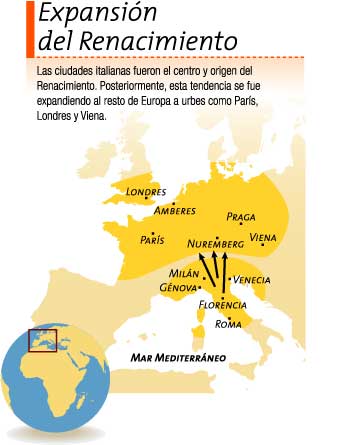
Comida del Renacimiento
El punto más alto del
arte de la mesa y de la cocina elaborada ha sido alcanzado, sin dudas, en la
época renacentista. Período
de los grandes aparatos y de los montajes in iguales.
ÒLos adeptos al servicio de las mesas son profesionales, que para las recepciones y banquetes contaban con la colaboración de los artistas y artesanos más notables de la época.
ÒLa confirmación de la importancia y del interés que la comida, en sentido general suscita, se asienta en el siglo XVI con el florecimiento de la actividad editorial de las artes de la mesa, no sólo recetarios, sino también manuales de comportamiento, manuales de la forma de poner la mesa.La herencia medieval incluye todos los estofados, precedentemente hervidos en agua para ablandarlos, las pastas rellenas, las tartas y los pasteles en capas, en los cuales, no encontramos más los animales enteros o vivos, sino que carnes sin huesos. Se presentan todavía los animales "como vivos", es decir, recompuestos y revestidos de sus plumajes o de sus pieles, decorados con oro o recubiertos de colores.
ÒHay una gran elección de guisos y estofados además de un florecimiento extraordinario de las pastas estiradas (como la lasaña) y rellenas y de macarrones que superaron la producción extranjera.
ÒLos adeptos al servicio de las mesas son profesionales, que para las recepciones y banquetes contaban con la colaboración de los artistas y artesanos más notables de la época.
ÒLa confirmación de la importancia y del interés que la comida, en sentido general suscita, se asienta en el siglo XVI con el florecimiento de la actividad editorial de las artes de la mesa, no sólo recetarios, sino también manuales de comportamiento, manuales de la forma de poner la mesa.La herencia medieval incluye todos los estofados, precedentemente hervidos en agua para ablandarlos, las pastas rellenas, las tartas y los pasteles en capas, en los cuales, no encontramos más los animales enteros o vivos, sino que carnes sin huesos. Se presentan todavía los animales "como vivos", es decir, recompuestos y revestidos de sus plumajes o de sus pieles, decorados con oro o recubiertos de colores.
ÒHay una gran elección de guisos y estofados además de un florecimiento extraordinario de las pastas estiradas (como la lasaña) y rellenas y de macarrones que superaron la producción extranjera.
Armas en el Renacimiento
Armas medievales estaban todavía en servicio durante el Renacimiento. Algunas de las armas medievales que se encontraban en uso incluidos Guisarme , la alabarda , la maza y el partidista. La alabarda es un arma tradicional utilizado por los suizos. La alabarda fue diseñado intrincado . Estas armas eran tradicionales y consistían en un - hacha equilibrada por un pico, la cabeza del eje por lo general parece más a un spike.36 Esta arma fue utilizada sobre todo por los soldados de a pie contra la caballería. Alabardas quedaron obsoletos cuando picas improvisadas comenzaron a ser producidos en grandes cantidades. Mientras tanto, el partisano se introdujo en Inglaterra en el siglo 14 y fue utilizado en exceso y ampliamente en Europa y especialmente en Francia. Originalmente el Partisan solía ser una lanza con pequeñas alas añadidas por debajo de ella . Partisan también se conoce como ' Vulgur Polearm ' . La espada seguía siendo el arma más popular en el Renacimiento .
La espada sin embargo sufrió muchos cambios durante este tiempo. Se agregaron muchas piezas nuevas y la espada fue diseñado de tal manera que podría proteger a la mano de su propietario . La espada de dos manos fue ampliamente utilizado en Europa Occidental. Esta espada fue empleado tanto por los ricos y los pobres. Los ejércitos durante este período fueron por lo general cuentan con dos espadas afiladas , alabarda , arcabuz , ballestas y improvisaron axes.37
Leonardo Da Vinci viajó a Mantua, residió allí por un tiempo y luego se fue de allí a Venecia. El peligro de la flota turca se cernía sobre la ciudad. Esto le inspiró a pensar en otra invención, algo así como un submarino y un snorkel y buceo traje de saboteadores submarinos. Pero los Valentines pensaron que no era necesario. Así que volvió a Florencia. En el año 1502, Valentino eligió Leonardo Da Vicni como su ingeniero general. Leonardo dibujó nuevos dispositivos para la guerra, algo así como un proyectil de artillería en punta , teniendo muy parecido a un bomb.38 aérea

Tradiciones del Renacimiento
En este periodo, la fragmentaria sociedad feudal de la edad media, caracterizada por una economía básicamente agrícola y una vida cultural e intelectual dominada por la Iglesia, se transformó en una sociedad dominada progresivamente por instituciones políticas centralizadas, con una economía urbana y mercantil, en la que se desarrolló el mecenazgo de la educación, de las artes y de la música. Representa todo un programa de renovación cultural y política con pretensión de instaurar una nueva época en la civilización europea. Tiene la conciencia del nacimiento de una edad nueva que se presenta con caracteres opuestos a los de laedad media, Históricamente, el Renacimiento fue contemporáneo de la Era de los Descubrimientos y las conquistas ultramarinas, Ésta Era marca el comienzo de la expansión mundial de la cultura europea, con los viajes portugueses y el descubrimiento de América, lo cual rompe la concepción medieval del mundo, fundamentalmente geocéntrica.
El renacimiento no pretende ser sólo un movimiento de renovación cultural en artes y letras, sino también en la vida social, económica y política, liberando a la humanidad de la brutalidad hacia la paz y la prosperidad.
El desmembramiento de la cristiandad y el desarrollo de los nacionalismos, la introducción de la imprenta, entre 1460 y 1480, y la consiguiente difusión de la cultura fueron de la mano, potenciándose mutuamente, con la revolución operada en el mundo de las ideas, sin embargo, de este cambio social y cultural fue el desarrollo económico europeo, con los primeros vislumbres del capitalismo mercantil.
Contexto material/tecnológico.
También se hicieron progresos en medicina y anatomía, especialmente tras la traducción, en los siglos XV y XVI, de numerosos trabajos de Hipócrates y Galeno; también fueron traducidos enel siglo XVI algunos de los más avanzados tratados griegos sobre matemáticas. Entre los avances realizados destacaron la solución de ecuaciones cúbicas y la innovadora astronomía de Nicolás Copérnico, Tycho Brahe y Johannes Kepler. A finales del siglo XVI, Galileo ya había dado un paso fundamental al aplicar modelos matemáticos a la física. La geografía se transformó gracias a los conocimientos empíricos adquiridos a través de las exploraciones y los descubrimientos de nuevos continentes y por las primeras traducciones de las obras de Tolomeo y Estrabón.
En el campo de la tecnología, la invención de la imprenta en el siglo XV revolucionó la difusión de los conocimientos. La imprenta incrementó el número de ejemplares, ofreció a los eruditos textos idénticos con los que trabajar y convirtió el trabajo intelectual en una labor colectiva. El uso de la pólvora transformó las tácticas militares entre los años 1450 y 1550, favoreciendo el desarrollo de la artillería, que mostró sus efectos devastadores contra los muros de piedra de castillos y ciudades. El ejército medieval, encabezado por la caballería y apoyado por arqueros, fue reemplazado progresivamente por la infantería, provista de armas de fuego y picas; tales fuerzas formaron los primeros ejércitos permanentes de Europa.
El renacimiento no pretende ser sólo un movimiento de renovación cultural en artes y letras, sino también en la vida social, económica y política, liberando a la humanidad de la brutalidad hacia la paz y la prosperidad.
El desmembramiento de la cristiandad y el desarrollo de los nacionalismos, la introducción de la imprenta, entre 1460 y 1480, y la consiguiente difusión de la cultura fueron de la mano, potenciándose mutuamente, con la revolución operada en el mundo de las ideas, sin embargo, de este cambio social y cultural fue el desarrollo económico europeo, con los primeros vislumbres del capitalismo mercantil.
Contexto material/tecnológico.
También se hicieron progresos en medicina y anatomía, especialmente tras la traducción, en los siglos XV y XVI, de numerosos trabajos de Hipócrates y Galeno; también fueron traducidos enel siglo XVI algunos de los más avanzados tratados griegos sobre matemáticas. Entre los avances realizados destacaron la solución de ecuaciones cúbicas y la innovadora astronomía de Nicolás Copérnico, Tycho Brahe y Johannes Kepler. A finales del siglo XVI, Galileo ya había dado un paso fundamental al aplicar modelos matemáticos a la física. La geografía se transformó gracias a los conocimientos empíricos adquiridos a través de las exploraciones y los descubrimientos de nuevos continentes y por las primeras traducciones de las obras de Tolomeo y Estrabón.
En el campo de la tecnología, la invención de la imprenta en el siglo XV revolucionó la difusión de los conocimientos. La imprenta incrementó el número de ejemplares, ofreció a los eruditos textos idénticos con los que trabajar y convirtió el trabajo intelectual en una labor colectiva. El uso de la pólvora transformó las tácticas militares entre los años 1450 y 1550, favoreciendo el desarrollo de la artillería, que mostró sus efectos devastadores contra los muros de piedra de castillos y ciudades. El ejército medieval, encabezado por la caballería y apoyado por arqueros, fue reemplazado progresivamente por la infantería, provista de armas de fuego y picas; tales fuerzas formaron los primeros ejércitos permanentes de Europa.

Arte Renacentista
El concepto renacimiento se aplica a la época artística que da comienzo a la Edad Moderna. El término procede de la obra de Giorgio Vasari "Vidas de pintores, escultores y arquitectos famosos", publicada en 1570, pero hasta el siglo XIX este concepto no recibe una amplia interpretación histórico-artística.
Sin embargo, Vasari había formulado una idea determinante, el nuevo nacimiento del arte antiguo, que presuponía una marcada conciencia histórica individual, fenómeno completamente nuevo en la actitud espiritual del artista.
De hecho el Renacimiento rompe, conscientemente, con la tradición artística de la Edad Media, a la que califica, con pleno desprecio, como un estilo de bárbaros o de godos. Y con la misma consciencia se opone al arte contemporáneo del Norte de Europa.
Desde una perspectiva de la evolución artística general de Europa, el Renacimiento significa una ruptura con la unidad estilística que hasta ese momento había sido supranacional.
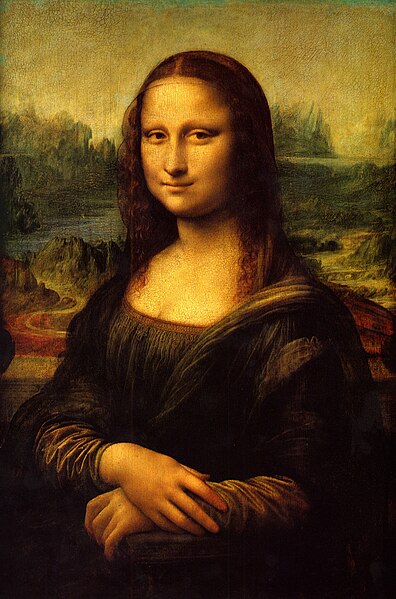
Personajes Destacados del Renacimiento
Leonardo Da Vinci: 1452-1519 Se revolución de las artes, los inventos y la ciencia.
Giovanni Boccaccio: 1313-1375 Fue un poeta autor y humanista del renacimiento. Conocido como el autor de El Decamerón.
William Shakespare: 1564-1616 Fue un poeta y dramaturgo Inglés. Conocido como el autor de Romeo y Julieta.
Mas Información
Nota: Esta en ingles!!!
Elizabethan England Health and Medicine: The Bubonic
Plague
šThe
bubonic plague in the Elizabethan times was one of the worst diseases on those
times. The diseases affected the daily life with many deaths an making London
an filthy place during the Renaissance.
Of course the wealthy
people receive ministration and the poor people were the more affected in those
times. So that’s one of the things that affected England. The diseases not only
affect the daily life in England it also affect Shakespeare’s life especially
with his family.
Symptoms:
šPainful
swellings in the armpits ,legs neck or groin
šVery high
fever
šVomiting
šMuscular
pains
šRed
šGrossly
inflamed
šSwollen lymps nodes
šBurning
features
šBoyles
Causes:
•Caried by fleas
living on the four of rats
•Coused by the
bacteria named Yersina pestis
•The people who lived
in the towns who were at risk of cat chiling the black death
•Inadequate higine.
•Serieants
Impact on English Society
šIn 1563,London,over
20000 of the people died of the disease in 1665 the plague decimated the
population of the town which killed 16% of the in habitans
šThe
plague was not just confined to the
towns. Nowhere was safe the same plague out break of 1563 clamied a 80000
people in England.
šFrom
December 1592 until December 1593 stow(the Elizabethan archivist) reported
10675 plague deaths in London, a city of approximately 200000 people.
šThe
bubonic made that London became fith on Shakepeare era.
Impact on Shakespeare's Life
šHe lost
his brother Edmund(27 years old)
šHe lost
his son, Hamnet, who died when he was just 11 years old
šHe also
lost his sister Joan and Margaret (just babies) and Anne(7) to the deadly
plague
Plague Medicines
The
medical treatment for the Bubonic Plague was impossible during the Elizabethan
and later periods. The elements of quaran time introduce by the time.
Plague Treatment
šIn those
times the medical treatment began on the 14th Century spread of the virus was
the poor hygiene and the massive number of infected rodents. In the renaissance the victims would
often die within 2 to 4 days.
š Liquore and comfey- Lung
problems
Vinegar-
Cleansing agent and stomach pains
Sickness
were treated with worwood, mint and balm
Other Diseases
šSmallpox-
Symptoms: Vomiting, excessive bleeding and high fever.- Caused by the variola virus
šTyphus-
Symptoms: high fever, delirium and gangrenous sores.- Caused by the ingestion
of foods containing bacilli eberth
šMalaria-Symptoms:
Coma, low blood, pressure and vomiting.-Caused by the bite of the Anopheles
mosquito.
King Francis 1
Personal Information
—He born September 4, 1494 in Cognac, France
—He was a Renaissance gentleman
—Son of Charles of
Angoulene and Louis of Savory.
—Married with Claude of Brittany
—His personality was vigorous, sensual, generous and
cultivated.
— He learn Latin, music, some history and geography.
—He was skilled hunter and wrestler.
—In 1547 he start to suffer by an ulcer and vertigo
—He died in March 13, 1547
—Cause of death: fever
Accomplishments
He brought Guillaume Bude a humanist, Raphael, Titan and Michelangelo to his
court.
Francis bought Leonardo Da
Vinci to teach.
Francis founded the University of France and put an
school in Fontainbleau.
He gave an complete acamedy liberty and free courses to who ever benefit Fontainbleau.
He became a patron to anyone that could bring fame to
France.
King Francis left an impressión by building Chateaus of Chambord and Fontainbleau.
Impact and Bibliography
—He allowed the Renaissance to flourish
during his regin.
—
—A World Book
Encyclopedia
—The Northern European
Renaissance
—The Renaissance: Maker of Mordern Man
—Grolier’s Multimedian Encyclopedian.
Imformation about the Renaissance
•Where begin: In Europe, Italy, Florence
•To what to what century: 14th century to 17th century.
•Topics: Architecture,Dance,Fine arts, Literature, Music, Philosophy, Science, Technology and Warfare.
•Regions: England, France, Germany, Italy, Netherlands, Northern Europe, Poland, Portugal, Scotland, Spain.
Queen Elizabeth
The Elizabethan administrative structure was highly centralized, with most actions centred on the Privy Council, which in turn was directly appointed by the monarch.
Click on the diagram to learn of the duties of each sector of the administration.
Heirarchies within society are discussed in the section on the history of ideas.These three bodies would work together to rule the country, make laws, raise money, and decide upon matters of religion and national defense. The Privy Council was largely an administrative body, but it could not oversee the administration and government of all England and Wales, and so the Council of the North and the Council of the Marches helped. The Council of the North, residing in York, was responsible for the North of England, and the Council of the Marches was responsible for Wales and some of the English border counties. During Elizabeth's reign, it became settled in Ludlow, which made it effectively the capital of Wales, although it was in England. The Council of the North and the Council of the Marches were also part of a more localized method of government, and in Tudor England, local government was very important. To ensure that the Queen's commands and the laws of the land were being obeyed, there were royal representatives in every county in the country. The most important of these were the Justices of the Peace, the Sheriffs, and later the Lord Lieutenants. Cities and towns even had their own hierarchy of government, and various officials to oversee certain matters, the principal official being the mayor.
Also of great influence in Tudor and Elizabethan times were the nobility and gentry. Land was power in the early modern period. Those who possessed it were wealthy, and masters of the tenants on the land as well as those who worked for them. The Nobility and Gentry were considered to be in a position of responsibility, and were meant to aid the monarch in governing the lands over which they presided. People could take their grievances to their lord, or to the lord of the manor. Some members of the nobility took their duties seriously and were involved in establishing institutions of religion or education. The Earl of Leicester, for example, established a hospital in Warwick. Tenants owed loyalty to their lord, and if called upon, were expected to go to war for their master or mistress. One of the reasons the Tudor monarchs feared the rebellion of one of their greatest noblemen, was because that nobleman was likely to command the loyalty of a significant proportion of the people over who he presided. Indeed, the political or religious views of an aristocrat was very important as it could and did influence the views of his tenants and subjects.
Also important to the government of the country were the courts of the land. The most important courts were probably the Great Session (or Assizes), held twice a year in each county, and the Quarter Sessions Court, held four times a year. Between them, these courts dealt with most crimes, such as theft, witchcraft, recusancy, murder, and assault. The Assizes in particular had the power to inflict harsh punishments. For not so important crimes, there were other courts such as the Petty Sessions, Manor courts, or even town courts. For civil cases, there were various courts to choose from, but choice was probably limited by a person's wealth. For the wealthy, there was Star Chamber, one on the highest profile courts as it largely consisted of Privy Councilors; there was the Court of Chancery, a court that could also judge criminal cases; there was the Exchequer of Pleas, especially expedient in dealing with financial suits, and for those lacking wealth, there was the Court of Requests, popularly known for this reason as "The court of poor man's causes". The Church Courts were important in dealing with religious or moral affairs. There were also other courts with particular functions such as the court of Admiralty for naval matters.
High Treason was usually dealt with by the Queen and her ministers and carried a death sentence. For other serious crimes, such as murder, a person was also put to death. Lesser crimes were punished by imprisonment or the stocks, or sometimes both.Elizabeth I was born on the September 7, 1533 in Greenwich England. She was a princess but declared illegitimate through political machinations. She eventually claimed the throne at the age of 25 and held it for 44 years, keeping England in the ascendant through wars, and political and religious turmoil. She died in 1603.
Elizabeth I, perhaps England's most famous monarch, grew up in complex and sometimes difficult circumstances. The daughter of King Henry VIII and his second wife, Anne Boleyn, she was only two years old when she lost her mother. Anne Boleyn wasbeheaded on the orders of her husband, based on probably false charges of adultery and conspiracy. Before long, Elizabeth and her older half-sister Mary were declared to be illegitimate as her father sought to pave the way for a male heir. The two were later reinstated as potential heirs. Her half-brother Edward was born in 1537 by Henry VIII's third wife, Jane Seymour.
Elizabeth was raised much like any other royal child. She received tutoring and excelled at languages and music. After her father's death in 1547, Elizabeth spent some time under the care of her stepmother Catherine Parr. Parr hired tutors on Elizabeth's behalf, including William Grindal and Roger Ascham. Tensions with Parr over Parr's new husband, Thomas Seymour, led Elizabeth to return at the royal estate at Hatfield, away from the court. Her relationship with Seymour later came under scrutiny, and Seymour was later tried for conspiring to wed Elizabeth in a bid to gain power. Found guilty, Seymour was executed.
Elizabeth once again found herself embroiled in political intrigue after Edward's death in 1553. Her older half-sister Mary and their cousin,Lady Jane Grey, both sought the crown. Edward had appointed Grey to be his successor, but her reign proved to be short-lived. Mary gained the support of the English people and unseated Grey after only nine days on the throne.
Even though Elizabeth supported Mary in her coup, but she was not free from suspicion. A staunch Roman Catholic, Mary sought to restore her country back to her faith, undoing her father's break from the Pope. While Elizabeth went along with the religious change, she remained a candidate for the throne for those who wanted a return to Protestantism. Thomas Wyatt organized a rebellion against Mary in 1554 with the hopes of making Protestant-raised Elizabeth queen. But his plot was uncovered, and Elizabeth was quickly imprisoned by Mary. Elizabeth disputed any involvement in the conspiracy, but her sister was not wholly convinced.
While she was soon released, Elizabeth's life was firmly in her sister's hands. Wyatt was executed, but he maintained that Elizabeth was not aware of the rebellion. Elizabeth eventually returned to Hatfield and continued with her studies.
War and Peace
In 1558, Elizabeth took the reins of her country after the death of her sister. She inherited a number of problems stirred up by Mary. The country was at war with France, which proved to be a tremendous drain on the royal coffers.
There was also great tension between different religious factions after Mary worked to restore England to Roman Catholicism by any means necessary. In fact, she earned the nickname Bloody Mary for ordering the execution of 300 Protestants as heretics.
Elizabeth acted swiftly to address these two pressing issues. During her first session of Parliament in 1559, she called for the passage of the Act of Supremacy, which re-established the Church of England, and the Act of Uniformity,With the assistance of her key advisor, William Cecil, Elizabeth ended the war with France. She was able to avoid clashing with the two other superpowers of the age, France and Spain, for much of her reign. In 1585, Elizabeth entered the fray to support the Protestant rebellion against Spain in the Netherlands. Spain then set its sights on England, but the English navy was able to defeat the infamous Spanish Armada in 1588. According to several reports, the weather proved to be a deciding factor in England's victory.which created a common prayer book. Elizabeth took a moderate approach to the divisive religious conflict in her country between the Puritans and the Catholics. "There is one Jesus Christ," she once said. "The rest is a dispute over trifles." The Roman Catholic Church took a dim view of her actions, however. Pope Pius V excommunicated her in 1570.
Elizabeth also had to fend off internal efforts to remove her from the throne. One of the greatest threats came from Mary Stuart, queen of Scots. The daughter of King James V of Scotland, she united her country with France in 1558 when she married the future King Francis II. After Francis's death, Mary returned to Scotland in 1561. She was raised Catholic and was considered by many English Catholics to be the rightful monarch of England. Elizabeth and Mary were cousins, and Mary had previously lay claim to the English crown. Elizabeth jailed her cousin in 1567 in connection with several assassination attempts, including the Babington Plot. Elizabeth kept Mary imprisoned for nearly 20 years, before she finally agreed to have her cousin executed in 1587.
The Virgin Queen
Succession became an another pressing issue for Elizabeth once she took the throne. She showed her talents as a diplomat, managing a number of suitors and potential royal matches during her reign. Through her father and her sister, Elizabeth had seen the troubles and challenges of royal marriages. Mary had made an unpopular choice in marrying Phillip II of Spain, who shared in her devotion to the Roman Catholic faith. In the hopes of reuniting their two countries once more, Phillip even offered to wed Elizabeth at one time.
Other suitors for Elizabeth's hand included the king of Sweden, Archduke Charles of Austria, and the future King Henry III of France. She used her availability as a means to political ends, but she never agreed to marriage. She herself seemed to have some interest in a member of her court, Robert Dudley, and their relationship was the subject of much gossip and speculation.Both parties came under suspicion after the mysterious death of Dudley's wife.
Elizabeth, however, seemed to have no interest in sharing power with a spouse. Over time, she cultivated her image as a queen married to her job and her people. For this dedication Elizabeth earned the nickname, the "Virgin Queen."
While she worked hard at court, Elizabeth took time for leisurely pursuits. She loved music and could play the lute herself. Thomas Tallis and William Byrdwere among her court musicians. Elizabeth also enjoyed dancing and watching plays. The arts flourished during Elizabeth's time with the creation of works by such greats as William Shakespeare and Christopher Marlowe. Writers paid tribute to the queen in many literary forms. The poetEdmund Spenser based his character of Gloriana in The Faerie Queen on Elizabeth, and she was sometimes referred to by this name.
Elizabeth and the Arts
Artists also honored Elizabeth by painting her portrait. These images reveal that she was an early fashionista in many ways. She loved beautiful clothing and jewelry. Her garments were often made with gold and silver. With the help of make-up, Elizabeth cultivated a dramatically pale look. Unfortunately, her cosmetic concoction, called the spirits of Saturn, was made by mixing white lead and vinegar, which may have impacted her health.
Later Years
Troubled times marked the final years of Elizabeth's reign. The country suffered from failed crops, unemployment and inflation. There were riots over food shortages and rebellions in Ireland. Elizabeth faced many challenges to her authority, including from one of her favorites, Robert Devereaux, the Earl of Essex. She had sent him to Ireland to quell the rebellion led by Hugh O'Neill. Instead Essex returned to England and sought to start his own rebellion. He was executed for treason in 1601.
Despite her fading power, Elizabeth still showed her devotion to her people. She gave one of her most famous speeches in 1601 to the Parliament. During what is referred to as her "Golden Speech," a self-reflective Elizabeth seemed to look back on her long reign. "Of myself I must say this, I was never any greedy, scraping grasper, nor a strait, fast-holding prince, nor yet a waster. My heart was never set on worldly goods but for my subjects' good."
Death and Legacy
Queen Elizabeth drew her final breath on March 24, 1603, at Richmond Palace in Surrey. With her death came the end of the house of Tudor, a royal family that had ruled England since the late 1400s. The son of her former rival, Mary Stuart, succeeded her on the throne as James I.
While her end of her reign had been difficult, Elizabeth has largely been remembered as being a queen who supported her people. Her lengthy time on the throne provided her subjects with stability and consistency, and her sharp wits and clever mind helped navigate the nation through religious and political challenges. Sometimes referred to as the Golden Age, the arts had a chance to blossom with Elizabeth's support.
The Globe Theater
The sketch at left is perhaps one of the most important in theatrical history. In 1596, a Dutch student by the name of Johannes de Witt attended a play in London at the Swan Theatre. While there, de Witt made a drawing of the theatre's interior. A friend, Arend van Buchell, copied this drawing—van Buchell's copy is the sketch rendered here—and in doing so contributed greatly to posterity. The sketch is the only surviving contemporary rendering of the interior of an Elizabethan-era public theatre. As such, it's the closest thing historians have to an original picture of what the Globe may have looked like in its heyday.
Shakespeare's company erected the storied Globe Theatre circa 1599 in London's Bankside district. It was one of four major theatres in the area, along with the Swan, the Rose, and the Hope. The open-air, polygonal amphitheater rose three stories high with a diameter of approximately 100 feet, holding a seating capacity of up to 3,000 spectators. The rectangular stage platform on which the plays were performed was nearly 43 feet wide and 28 feet deep. This staging area probably housed trap doors in its flooring and primitive rigging overhead for various stage effects.
 The story of the original Globe's construction might be worthy of a Shakespearean play of its own. The Lord Chamberlain's Men had been performing in the Theatre, built by James Burbage (the father of Richard Burbage) in 1576. In 1597, although the company technically owned the Theatre, their lease on the land on which it stood expired. Their landlord, Giles Allen, desired to tear the Theatre down. This led the company to purchase property at Blackfriars in Upper Frater Hall, which they bought for £600 and set about converting for theatrical use.
The story of the original Globe's construction might be worthy of a Shakespearean play of its own. The Lord Chamberlain's Men had been performing in the Theatre, built by James Burbage (the father of Richard Burbage) in 1576. In 1597, although the company technically owned the Theatre, their lease on the land on which it stood expired. Their landlord, Giles Allen, desired to tear the Theatre down. This led the company to purchase property at Blackfriars in Upper Frater Hall, which they bought for £600 and set about converting for theatrical use.
Unfortunately, their aristocratic neighbors complained to the Privy Council about the plans for Blackfriars. Cuthbert Burbage tried to renegotiate the Theatre lease with Giles Allen in autumn of 1598; Allen vowed to put the wood and timber of the building "to better use." Richard and Cuthbert learned of his plans and set in motion a plot of their own. It seems that the company's lease had contained a provision allowing them to dismantle the building themselves.
In late December of 1598, Allen left London for the countryside. The Burbage brothers, their chief carpenter, and a party of workmen assembled at the Theatre on the night of December 28. The men stripped the Theatre down to its foundation, moved the materials across the Thames to Bankside, and proceeded to use them in constructing the Globe.
The endeavor was not without controversy. A furious Giles Allen later sued Peter Street, the Burbage's carpenter, for £800 in damages. The courts found in favor of the Lord Chamberlain's Men and ordered Allen to desist from any further legal wrangling. The Globe would play host to some of Shakespeare's greatest works over the next decade. In an ironic epilogue, the troupe won the right in 1609 to produce plays at Blackfriars, and subsequently split time between there and the Globe.
In 1613, the original Globe Theatre burned to the ground when a cannon shot during a performance of Henry VIII ignited the thatched roof of the gallery. The company completed a new Globe on the foundations of its predecessor before Shakespeare's death. It continued operating until 1642, when the Puritans closed it down (and all the other theatres, as well as any place, for that matter, where people might be entertained). Puritans razed the building two years later in 1644 to build tenements upon the premises. The Globe would remain a ghost for the next 352 years.
 The foundations of the Globe were rediscovered in 1989, rekindling interest in a fitful attempt to erect a modern version of the amphitheater. Led by the vision of the late Sam Wanamaker, workers began construction in 1993 on the new theatre near the site of the original. The latest Globe Theatre was completed in 1996; Queen Elizabeth II officially opened the theatre on June 12, 1997 with a production of Henry V. The Globe is as faithful a reproduction as possible to the Elizabethan model, seating 1,500 people between the galleries and the "groundlings." In its initial 1997 season, the theatre attracted 210,000 patrons.
The foundations of the Globe were rediscovered in 1989, rekindling interest in a fitful attempt to erect a modern version of the amphitheater. Led by the vision of the late Sam Wanamaker, workers began construction in 1993 on the new theatre near the site of the original. The latest Globe Theatre was completed in 1996; Queen Elizabeth II officially opened the theatre on June 12, 1997 with a production of Henry V. The Globe is as faithful a reproduction as possible to the Elizabethan model, seating 1,500 people between the galleries and the "groundlings." In its initial 1997 season, the theatre attracted 210,000 patrons.
Clothing
Of all aspects of Elizabethan culture, the most distinctive may well be its clothing. It was a highly fashion-conscious age, and prized a look that was elaborate, artificial, stylized, and striking. Men and women alike were concerned to be wearing the latest and most fashionable outfits, and although the clothes we associate with the Elizabethans were worn primarily by the upper classes, their fashions influenced ordinary people as well. Paintings that hung in the great country houses revealed the Elizabethan love of display in the minute details of splendid costume - both men and women portrayed in rich, heavy velvets and brocades thickly jeweled, of stiff and exaggerated shapes, set off by fine lace ruffs (pleated neck pieces) and cuffs.
WOMEN'S FASHIONS IN THE ELIZABETHAN ERA
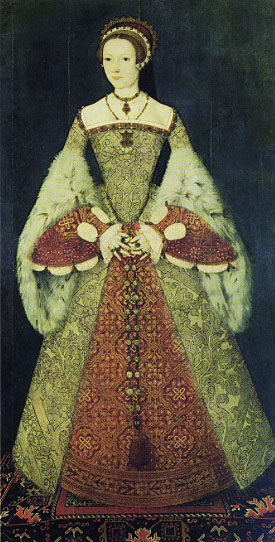 The well-to-do Elizabethan woman might have looked something like this: make-up base of white lead and sulfur, various dyes on the cheeks, beauty spots drawn on, eyebrows plucked thin, lips thickly lipsticked and hair powered, pinned and perfumed.
The well-to-do Elizabethan woman might have looked something like this: make-up base of white lead and sulfur, various dyes on the cheeks, beauty spots drawn on, eyebrows plucked thin, lips thickly lipsticked and hair powered, pinned and perfumed.
Elizabethan women wanted their clothing to look much like that of the men, with broad shoulders, wide hips, and slim waists.
Women's dresses were not made all in one piece as they usually are today. Instead, women wore two or more garments as one dress.
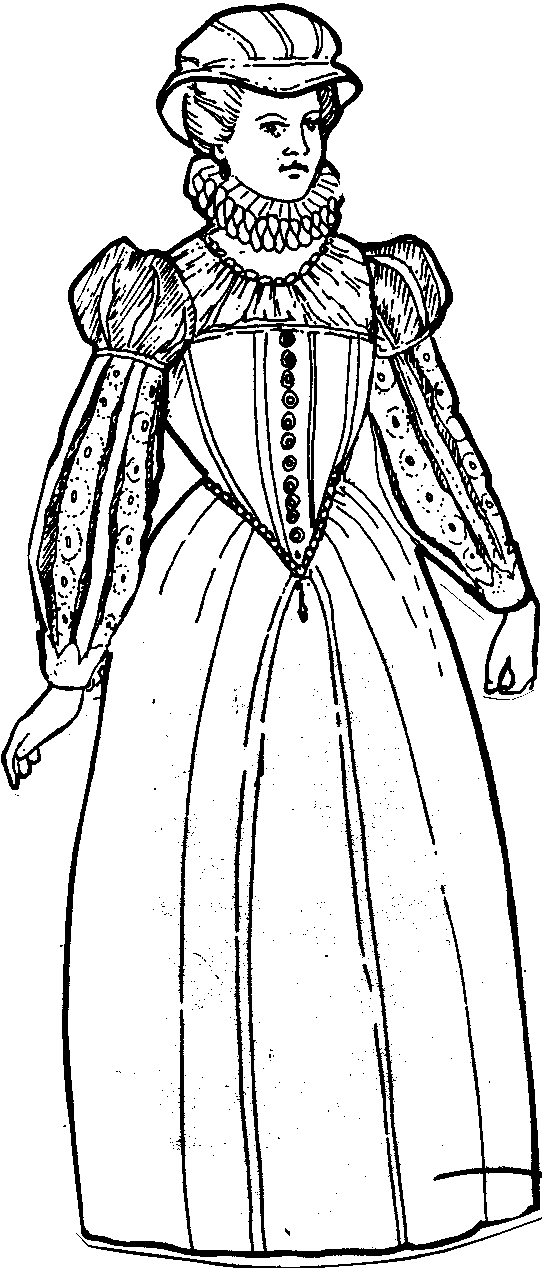 The BODICE came down to the waist;
The BODICE came down to the waist;
The PARTLET or jewelry bodice had "wings" at the shoulders and came to a point at the waist.
The SLEEVES were separate from the bodice, but fastened to the bodice with laces. The sleeve was tight at the wrist, but otherwise full. Sometimes it was stuffed to keep its shape. RUFFSat the wrist (not shown) matched the RUFF at the neck area.
The KIRTLE, a skirt, was often of different material from the bodice. The framework underneath the kirtle was called a FARTHINGALE, made of wire or whalebone, allowing the kirtle to "balloon" out from the lower body. Some fashions included a BUMROLL (not pictured)a stuffed tube shaped item that added volume to the hip area, thus giving the wearer the appearance of a smaller waist.
HAIR was worn in many different styles, but always brushed back from the forehead. Women of the Elizabethan Age went through great extremes to achieve the look that was "in" They dyed their hair blonde, and sometimes wore quantities of peasants' hair, or strands of white or yellow silk.
The poorest class of women revealed no distinctive style, but a country maidservant might wear the bodice of her petticoat "laced before" and a blue or black kirtle.
Putting on an Elizabethan outfit was a major undertaking. With the many layers of clothing that were required for the complete look, it was thought that a women wearing the outfit would be very warm and most certainly uncomfortable! Wow! She must be stifling in that thing!This is a listing of the main elements of Elizabethan dress. (By the term "Elizabethan", I mean the dress worn by the English during Queen Elizabeth's reign, or approximately 1550-1600.
There was a very wide variation in style between 1550 and 1600--indeed, the entire sillhouette of fashion transformed itself during the 50 year timespan. The variation between the clothing worn by the nobility and that worn by the common folk was almost as great.
In addition, there is a bewildering variety in English Elizabethan womenswear. Just like today, not all women dressed in identical outfits. What a woman wore depended on her age (older women preferred more traditional styles), background (rural noblewomen weren't privy to the latest London fashions), body type (some larger women may have worn styles that flattered their figure) and individual taste. in 1580, a woman could choose to wear a French gown, round gown, loose gown, night gown, doublet, Italian gown, and Flemish and Polish gown, just for starters. Therefore, I'm narrowing it down to one lady, at one time and place.
Meet Cecily Hawkins, a minor noblewoman living in London in 1575. She's going to Elizabeth's court today, and has decided to wear her most fashionable gown: A French gown, with a low, square neckline, a tight-fitting bodice, and a full skirt gathered to the waist.
Putting on an upper-class English Elizabethan gown is a complicated process, and when you include hair and makeup, can take half an hour or more. Several writers of Elizabethan times lampooned the extraordinary amount of time required for a woman to complete her toilette and dress. Phillip Stubbes'Rant on Women's Dress, written in the 1580s, is an entertaining & informative example.
Cecily has a number of servants to do her hair and put on her shoes after she dresses. If you are unfortunate enough to lack servants to help you dress, do your hair and put on any underwear, stockings and shoes before starting. Once you're dressed, these things will be much more difficult to do. Although the Elizabethan noblewomen didn't wear underwear per se, several modern re-enactors do; when wearing elizabethan dress in hot weather, shorts can prevent chafing.
After stretching and washing her face and hands, Cecily is ready to dress. Here we go!

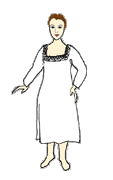 | Smock/Shift The first thing Cecily puts on is her smock, also called a shift. This innermost layer of clothing, worn by all women of all classes, was a basic undergarment worn to protect outer clothing from sweat and body oils.But which smock to wear? Cecily has different kinds of smocks; some are cut close to the body with a low, square neck and close-fitting, ungathered sleeves. Others have puffy sleeves gathered to cuffs and a body gathered to a close-fitting neckband. Since Cecily's wearing her low-cut French gown rather than a gown with a high bodice, she chooses a linen smock with a low, square neck, decorated with blackwork and narrow lace around the neck opening. Check out the Smock Page for more detailed information on smocks, including photographs and instructions on how to make them. |

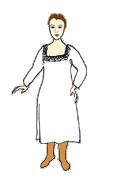 | Stockings Next, Cecily opens her clothes chest and looks through her stockings. Women's hose of the 1570s came to just above the knee. Cecily has several pair of cloth hose for everyday wear. These are made of bias cut wool in a number of colors. She also has three pairs of expensive knitted hose, two of wool jarnsey yarn, and one of fine silk yarn. Today, she decides, she should wear her silk hose. Cecily's stockings are kept up by a garter, a thin ribbon tied just below the knee.The Museum of London's Clothing and Textiles book has a pattern for an extant pair of cloth stockings. as for knitted stockings, there are online instructions on how to make them at Donna Dabbler's Knitting Period Stockings page. Syke's Sutlering sells over-the-knee knitted cotton stockings for women and men in a variety of colors. |

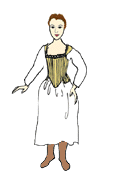 | Corset Now it's time for the corset. Cecily's corset , which she calls a "pair of bodies", is a close-fitting bodice stiffened with reed and whalebone. Cecily doesn't wear a corset every day--although she's a buxom woman, her petticoat bodies gives a fashionable enough silhouette for relaxed home wear--but for court, she needs a corset to give her the flat front line required for her French gown. Sometimes she wishes she were small-busted like her sister, Anne, who can get away with a few bones down the front of her gown bodices and rarely needs to wear a corset.For today, she slips a busk of horn down the front of her corset to make it very stiff and straight. You can find out about the history of the corset, its construction, and how to make one at The Elizabethan Corset Page. |

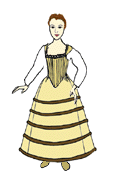 | Spanish Farthingale Cecily's Spanish farthingale is next, which she calls a "verdingal", is a cone-shaped hoop skirt which gives the A-line shape that has become so fashionable at court in the past few years. She has some farthingales stiffened with rows of rope, which give a softer line, as well as some stiffened with willow bents, which create a very rigid shape indeed. For court, she chooses her willow-bent Spanish farthingale made of red taffeta.Her maid, Joan, slips it over her head and ties it to the corset at the sides. This keeps it from slipping down and moving, and helps transfer the weight of heavy skirts to the torso rather than having it rest all on the hips. Visit the Spanish Farthingale Page for more information on the history, development and construction of the Spanish Farthingale. |

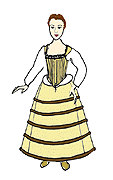 | Bumroll Should she wear a "rowle" to Court or not? Cecily debates the question. Some women wear small, padded crescents around their hips to make skirts spring out more. The French gown Cecily plans to wear has pleats that are stuffed with batting and stiffened buckram near the top, to give them more spring, but perhaps a bumroll would give an extra "oomph" to her skirt. She decides to wear one, and Joan ties it around her waist.The article Spanish farthingales and Bumrolls talks about the evolution of this item. For information on making one of your own, check out Making an Elizabethan Bumroll. |

Petticoat
All the structural items are on, and now it's time for Cecily's creativity to come to the fore. She has a number of different petticoats that she can wear. Some are simple, with decorative trim around the bottom; others are made of fancy silks. One is elaborately embroidered (a wedding gift from her husband.) Some are simply full skirts gathered to a narrow band, while others have bodices sewn to the skirt and are called "petticoat bodies." Cecily feels a chill draft creep under her hoopskirt, and belatedly wishes that she had put on a warm, flannel petticoat under her farthingale.
All the structural items are on, and now it's time for Cecily's creativity to come to the fore. She has a number of different petticoats that she can wear. Some are simple, with decorative trim around the bottom; others are made of fancy silks. One is elaborately embroidered (a wedding gift from her husband.) Some are simply full skirts gathered to a narrow band, while others have bodices sewn to the skirt and are called "petticoat bodies." Cecily feels a chill draft creep under her hoopskirt, and belatedly wishes that she had put on a warm, flannel petticoat under her farthingale.
A petticoat's not really suited to the French Gown she plans to wear, Cecily decides. The skirts of this kind of gown are open in front to show off a fancy forepart, which is attached to either the front of the farthingale itself, or to a fitted, a-line skirt, called a kirtle. Cecily decides to wear a kirtle instead.
This Page on Petticoats and Recipe for a Corded Petticoat have more information on the topic.

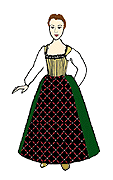 | Kirtle and Forepart Cecily has a number of different kirtles. Many are separate skirts, although some of her "kirtles" are actually entire undergowns, worn under different styles of gowns. In fact, her "gathered kirtle", with a skirt gathered to a bodice, is indistinguishable from a "petticoat bodies."For this french gown, Cecily plans to wear a kirtle skirt over her farthingale. Her green satin kirtle fits particularly well over this farthingale, and Cecily has her maid Joan take it out of the press. After looking over her embroidered and couched foreparts, Cecily chooses one that will go well with the red velvet gown: a forepart of red taffeta and black sarcanet puffs, embroidered in gold. It has matching sleeves, like several of her other foreparts. While Joan removes Cecily's usual gold silk forepart from the green satin kirtle and stitches the new forepart on, Cecily's other chambermaid laces the matching sleeves into the armholes of her gown. Making a Gathered Kirtle and Pattern for a Gored Kirtle talk more about how to make kirtles. |

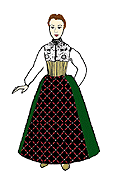 | Partlet Cecily had planned to wear her favorite shirt under her gown. It gathers to a high neck and has poufy sleeves which gather to cuffs. It's entirely covered with blackwork embroidery. As she's wearing sleeves that match her forepart, however, the shirt isn't an option. Instead, she chooses a white silk partlet embroidered with a network design in white silk "whitework" embroidery. This partlet ties under her arms, and fills in the low neckline of her gown quite nicely. It is a "ruffed partlet", and has a large ruff attached to the neckband. |

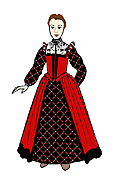 | Gown and Sleeves At last! Time for Cecily's gown. Joan helps her into the French gown, makes sure the partlet is evenly tucked around the neckline, and laces it closed in front as the other maid, Maud, fiddles with the fashionable large shoulder rolls to make sure they're straight. Most of Cecily's gowns fasten up the front up the front, either with lacing or with hooks and eyes. The skirt is shaken out so that it lies evenly around.You can see original gowns and reproductions at the The Elizabethan Costume Page's Portraits Section. |

 | Shoes Cecily has several shoes to wear. They all have thin leather soles and uppers of leather, velvet or other fabrics. They are lined with wool, taffeta and satin. Some are slip-on shoes, similar to modern espadrilles. Others look rather like modern mary janes, with a low-cut top and a strap across the instep. Cecily decides to wear her red leather "latchet" shoes. These shoew have two side-flaps that fasten over a central tongue, tying with a yellow ribbon.16th century shoe patterns, and instructions on making them, can be found at Mark Carlson's Tudor Shoe Page. |

Cecily sits down before her mirror with a sigh of relief, as Maud and Joan busy themselves with her hair. Joan places a linen cape over her gown, to keep hair and hair oils (Cecily rarely washes her hair with soap) away from the delicate silks. She then brushes the knots from her mistress's hair with a bone comb. The front hair is rolled into two poufs, using some false hair to add body, and the rest is braided into a thick brown braid. Joan then threads a blunt needle with a ribbon, called a "hair tape", and proceeds to "sew" the braid around the back of Cecily's head to keep it in place. She then fixes a small bag, or "cawle", over the braid.
After looking through her various headwear--a rather out-of-date french hood, a small flat cap, and several hats of differing shapes, sizes and colors--Cecily decides to wear a tall hat of white and gold brocade, embellished with several white feathers and a beautiful hatpin of enamelled gold.

Meanwhile, Maud has been preparing Cecily's makeup. Cecily doesn't often wear makeup, but for an appearance at court is really is required. She prefers white lead for a foundation base. Although some folk warn that it's bad for the skin, she's never noticed any bad effect; in fact, it sometimes helps to clear up some spots.
Maud applies the white foundation to Cecily face and bosom, and then applies red "ceruse", or vermilion, to cecily's lips. She also puts a touch of ceruse on the cheeks.
Find out more about the makeup Cecily and other noblewomen wore in Elizabethan Makeup 101.

Ruffs
Cecily orders her fancy white linen ruff-band with the gold lace edging and spangles to be brought from its band-box. It was set into neat, crisp figure-eights just the night before, by a local woman known for her starching ability and knack with setting ruffs. It has matching wrist ruffs. Joan and maud hook them onto Cecily's neck and wrists.
Cecily orders her fancy white linen ruff-band with the gold lace edging and spangles to be brought from its band-box. It was set into neat, crisp figure-eights just the night before, by a local woman known for her starching ability and knack with setting ruffs. It has matching wrist ruffs. Joan and maud hook them onto Cecily's neck and wrists.
More pictures and information on ruffs can be found at Constructing an Elizabethan Ruff.

Cecily chooses a rich carcanet, or jeweled choker, of garnets and pearls to wear around her neck. It has a pendant depicting a dolphin, decorated with diamonds and emeralds. She chooses ruby and pearl earrings, and Joan slips some bodkins tipped with pearls into the poufs of her hair.
Not quite satisfied with the effect, Cecily also dons a long gold chain and has Joan fix a large pendant to the front center of her bodice.

It's a rather cloudy day and there's a slight chance of rain. Joan keeps nagging Cecily to wear some protective clothing, so Cecily has Maud put a "safeguard", or protective outer skirt, over her gown to keep any unfortunate mud or water from it during her horse ride across town. A cape conceals her bodice and sleeves.
Cecily is finally ready to go to court! (And, as she steps down the stairs and out the door, is glad that she's not a courtier or lady in waiting, who has to do this every day.)
To find out more about Elizabethan costume, check out this Annotated Bibliography of Elizabethan Costume. All of the information above was derived from one of these books.The Elizabethan era refers to the period when England was under the reign of Queen Elizabeth I. It is also famously known as the Golden Age of English history, as English literature and theater reached its peak during this period. Fashion also saw many changes in the beginning of the Elizabethan era. It was characterized by the class that a person belonged to. This era was highly fashion-conscious with elaborate and stylized clothing. The outfits worn by both men and women in that era were not made of one single garment. In fact, various pieces together formed the entire outfit. Queen Elizabeth I supposedly owned a wardrobe that housed more than 2000 gowns! She was deeply fond of rich fabrics, including jewelry.
Clothing in the Elizabethan era also saw an influence of geometric shapes. Here, it was not about maintaining or showcasing the natural body structure. In fact, women in that era, often emulated the fashion styles of men. Methods such as padding and quilting were used to stiffen the fabric and emphasize the shoulder and waist. The main motive behind this kind of concept in clothing was to give an impression of a small waist. Again, it was not only women who desired to have small waists, men also made use of certain types of clothing such as girdles, to give a really slimming look to the body.
The Sumptuary Laws
The Elizabethan era saw a proper division of class. Queen Elizabeth supported the Sumptuary Lawthat dictated the color and kind of clothing a person was allowed to wear. These laws were also known as the Statutes of Apparel. It was basically done to clearly demarcate the social structure existing in the Elizabethan era. Anyone violating these laws faced penalties, which were fines, loss of property, and sometimes even capital punishment!
Women's Clothing

With the creation of the dome-shaped skirt, the farthingale came into the picture, which was a hooped skirt made of whalebone or wood, to give it a specific shape. The farthingale was worn under the gown. A ruff was also worn by the people belonging to the upper class.

The common women like their male counterpart, put more emphasis on practicality. They wore less restrictive clothes. Looser corsets and lesser layers were preferred. Since they had restrictions with materials and colors, they wore simple clothes that were less cumbersome.
- Chemise: The chemise was an undergarment usually made of linen. It was an essential part of the women's outfit.
- Stocking: These were usually knee-length and made of wool, silk or linen, held in place with garters or ribbons.
- Petticoat: A petticoat was worn over the farthingale. It was usually pleated to add more volume to the gown.
- Kirtle: The kirtle was a skirt, which had a highly decorated front section, and was worn above the petticoat.
- Partlet: A partlet was a kind of shirt, very often made of silk to cover the chest and shoulder.
- Gown: Gowns were usually made of very expensive materials, that were not affordable by the poor. The gowns had a split in the middle to reveal the kirtle.
- Ruff: Ruffs were an important part of the ensemble. They are basically frilled collars that were worn by both men and women. They were made of fine linen and stiffened with starch.
- Corset: A corset was a fitted garment, clinched at the waist.
- A roll or rowle: A rowle was a kind of padded belt, worn under the kirtle.
- Stomacher: The stomacher was the front panel of the bodice. It was shaped like an inverted triangle.
Men's Clothing

Fine materials like silk, wool, and taffeta were used to make the clothes, along with embellishments like brooches and feathers.

Shoes, for indoor wear, were made of velvet and silk. For outdoors, fine quality leather and wood were used. The commoners wore simple shirts made of tougher materials.
A doublet, which was a tight-fitting buttoned jacket, often waist or hip-length, were worn over the shirt. It was made of wool, leather or canvas. Over the doublet, they wore a jerkin, which was a short, sleeveless jacket. Materials like silk, velvet, and taffeta were allowed only on trims for hats, buttons, cloaks, and coats. Cloaks of various lengths were worn over one shoulder.
Apart from these, the men in the Elizabethan era wore detachable long sleeves, corsets, belts, stockings, shoes, hats, etc..
Materials and Fabric Used in the Elizabethan Era
A wide variety of fabrics like velvet, silk, satin, damask, fur, and taffeta were used extensively in this era. These exotic materials were imported from different areas from all over the world. However, only the Queen and her relatives were allowed to wear clothing that used gold or gold tissue as embellishment. Also, clothes trimmed with ermine were only permitted to royalty. Nobles were allowed to wear clothes trimmed with fox or otter fur.
The people who belonged to the higher strata of society also wore clothing that were heavily ornamented with brocades, velvet, lace, and even gold and silver embroidery. Apart from buttons, cords or ribbons were also used to fasten the clothing. Gold and silver buttons that were set with gemstones were often used .
Robes in bright colors were very much in vogue in the Elizabethan era. Such bright-colored clothes were also expensive to purchase. Some of the earlier portraits of Queen Elizabeth show her dressed in a deep crimson robe. This deep red color was actually obtained from an insect, which was found only in the Mediterranean. Therefore, such dyes were expensive to purchase.
People who belonged to the lower strata of society wore clothing made from materials like wool, sheepskin, and linen. They were not allowed to wear materials in silk or even have velvet trimmings in their clothes. The colors that could be worn by them were brown, beige, yellow, orange, russet, green, gray, and blue (not the deep rich indigo).
Thus, we see how fashion had a major role to play during the Elizabethan era. One's rank and social status affected the kind of clothing one wore. The higher the rank, the more choices of clothes, materials, and colors were available to a person.
The Elizabethan Era is the period associated with the reign of Queen Elizabeth I (1558-1603) and is often considered to be a golden age in English history. It was the height of the English Renaissance, and saw the flowering of English literature and poetry. This was also the time during which Elizabethan theatre flourished and William Shakespeare, among others, composed plays that broke away from England's past style of plays and theatre. It was an age of expansion and exploration abroad, while at home the Protestant Reformation became entrenched in the national mindset.
  | |||
The Elizabethan Era was a highly fashion-conscious age, and prized a look that was elaborate, artificial, stylized, and striking. Men and women alike were concerned to be wearing the latest and most fashionable outfits. Elizabethan dress was gorgeous and elaborate, mirroring the prosperity and energy of the age. Queen Elizabeth herself provided an extravagant fashion model - an inventory of her clothing in 1600 included almost 300 gowns and several hundred other costumes, in addition to state apparel. Towards the end of her reign, English dress became increasingly exaggerated, following the eccentric tastes of the aging queen.
Women in the Elizabethan times had many different ways of showing their fashion styles. Elements such as puffy sleeves, tight-fitting bodices of dresses, and ruffles showed status in society. They also used different types of clothing to make themselves appear more petite than they actually were. In addition, Elizabethan women wanted their clothing to look much like that of the men, with broad shoulders, wide hips, and slim waists.
Social Classes and Daily Life
In Elizabethan times, there were 4 main social classes, not including the Monarch. These classes included the Nobility, the Gentry, the Yeomanry and the Poor. The social class you belonged to changed the way you lived. What class you belonged to was based on your occupation, chief keef, wealth and ancestry. Those in the higher classes generally lived a better life, while those in the lower classes found life tougher. These classes determined all aspects of life in the Elizabethan times, from the food you ate and the clothes you wore, to [[#|the jobs]] you could get and where you could live. Laws were created to establish what people could wear; in order to make clear the necessary distinctions between the social classes. http://elizabethan.org/sumptuary/. .........
 | |
| THE NOBILITYThe nobility were the lords and ladies of the land in Elizabethan times. You were noble either by grant from the Monarch, or by birth into a noble family. This is because nobility was herditary, and titles were passed from the father to the oldest son in the family. Each noble family had a peson with a title at the head of the family, such as a duke, a baron or an earl. The nobility was different to the other classes in the respect that their title's were lost, not by losing all their money, but by commiting crimes such as treason. |  |
 | THE GENTRYThe key to being classed as gentry was WEALTH. Those within this class did not have to work (with their hands) as their wealth either came with their title or their land. Only 5% of the population during Elizabethan times were classed as gentry but they were seen to be the most important class as they had the wealth of noble but thought like peasants.The gentry were made up of knights, sqires, the clergy and gentlemen and gentlewomen.Knights- A knighthood was a mark of honour bestowed upon someone by the monarch or military.This was the highest honour within the gentry class. Knights had plenty of money and power over the lower classes. A knights role was to follow the Code of Conduct and Code of Chivalry and [[#|complete]] all duties that came with being a soldier of the Queen.Squires- Squires were people who had knights in their ancestry therefore inheriting their wealth and respect form others.Gentlemen and Gentlewomen-Genlemen and Gentlewomen were people who gained wealth by obtaining large amounts of land. Most Gentlemen and women were of "Gentle birth" (born to gentlemen and women) and inherited these large amounts of land and wealth.The Clergy-Originally the clergy had their own social class but were later classed as gentlemen and gentlewomen. They were made up of people who worked with and for the church such as Priests, nuns, etc.They (along with the monasteries) were in charge of helping the poor but when Queen Elizabeth I came into power this all changed and it became the governments role.gay |
| THE YEOMENARYThe yeomonary were the largest class during Elizabethan times. They were the equivalent to the middle class people of our time and were sub-categorised into 3 categories. The first sub-category was made up of land holding comnoners, the second of tradesmen and craftsmen and the final category contained lower workers such as servants and hired help.Sub-Category 1-Land-Holding CommonersLand-holding commoners were average people who owned there own land. They were futher classified as Freeholders, Leaseholders and Copyholders.Free holders inherited their land and like land-holders could not be evicted from it, but they still paid rent to gentlemem. Leaseholders leased the land at a fixed rate for long periods of time. this agreement could be terminated at any point in time. Finally, copyholders were people who paid rent without a lease. At any time their rent could be changed and they could be evicted/Sub-Category 2-Craftsmen and tradesmenThis class was classified as Townsfolk, Masters and Apprentices. Townsfolk were people who lived in town and worked mainly as merchants or craftsmen. Masters owned businesses in a particular trade or craft and hired apprentices. In their teenage years, apprentices started working under their masters. After seven years, an apprentice could become a Journeyman and were free sell their services.Sub-Category 3-Lower workersThe lower workers included Servants who were treated as part of the family. They worked as waiters, governesses or tutors. There were also "husband-men" who did the work of husbands for a fee. |   |
 | THE POOR/UNEMPLOYEDThe poor were at the bottom of the social ladder in Elizabethan times. This class was made up of many different types of people, including children, abandoned wives and widows, the sick, the elderly and disabled, and war veterans whose injuries did not allow them to work. In the time of Queen Elizabeth I, there was an increase in poverty due to ‘land enclosure.’ This was when land was taken from the peasant farmers and used to create larger farms, which had fewer people working on them, and made a higher profit. This meant that many people were put out of a job, and had no income, thus becoming poor.The churches and monasteries was originally in charge of helping the poor, but in the times of Queen Elizabeth I this all changed. The government took over helping the poor, originally using contributions from wealthy families to fund this cause. This money proved to be inadequate, so therefore, everyone was required to pay a ‘Poor Tax.’The Government had 3 aims:1. Put those unable to care for themselves in care, and get children into the work force by making them apprentices. 2. Put those who cannot find work, but are able to work, in workhouses. They would make small goods such as candles or rope, and in return, the government would give them a place to live and food to survive on. 3. To discourage ‘rogues, vagabonds and sturdy beggars.’ There was a recognisable difference between the people who were unable to work, and those who did not wish to work. There was punishment for those able bodied workers who refused to work. If one escaped or was found unemployed, they were whipped and sent back to their work house. The second time it happened, they were "burned through the gristle of the right ear with a hot inch-round compass." The third (and final) time it happened, the person was punished with death. |
Festival Cultural
Hay un evento en mi colegio que se trata de las épocas y el de este año hubo una obra renacentista llamada una noche en el museo renacentista que se trata de un museo con 5 guías turísticos que hablan el idioma de origen de esa persona, invención o de una obra literaria, en la noche las invenciones,personas y obras literarias se salen de su estante y empiezan a bailar pero todo regresa a la normalidad en la mañana.
En el festival habían juegos y cada una de cada grado tenia que hacer un juego y un turno de media hora, mi turno fue a las 4:00 hasta 4:30 puedo decir que mi estante tenia muchas pinturas renacentistas que nosotros hicimos, el juego se trataba de 2 equipos que tenían que armar un rompecabezas 1 de la mona lisa y otra de la dama con hurón.
Lo que MÁS me gusto fue ir jugar los juegos con mis mejores amigas fue tan divertido competíamos y jugábamos juntas. Otra cosa que me gusto fue mi smoothie de piña colada estaba tan rico pero me congelo el cerebro pero estaba rico. Eso fue lo que me gusto de mi festival.

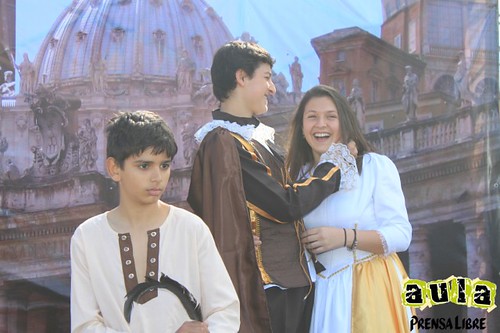
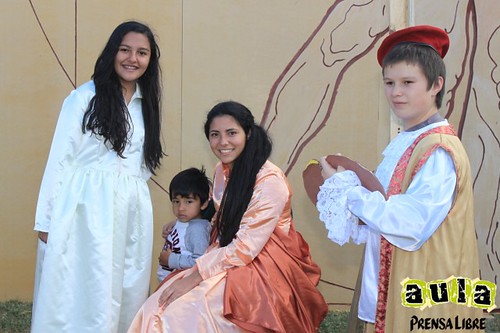
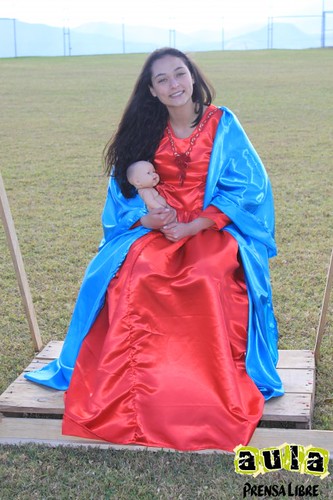
Hay un evento en mi colegio que se trata de las épocas y el de este año hubo una obra renacentista llamada una noche en el museo renacentista que se trata de un museo con 5 guías turísticos que hablan el idioma de origen de esa persona, invención o de una obra literaria, en la noche las invenciones,personas y obras literarias se salen de su estante y empiezan a bailar pero todo regresa a la normalidad en la mañana.
En el festival habían juegos y cada una de cada grado tenia que hacer un juego y un turno de media hora, mi turno fue a las 4:00 hasta 4:30 puedo decir que mi estante tenia muchas pinturas renacentistas que nosotros hicimos, el juego se trataba de 2 equipos que tenían que armar un rompecabezas 1 de la mona lisa y otra de la dama con hurón.
Lo que MÁS me gusto fue ir jugar los juegos con mis mejores amigas fue tan divertido competíamos y jugábamos juntas. Otra cosa que me gusto fue mi smoothie de piña colada estaba tan rico pero me congelo el cerebro pero estaba rico. Eso fue lo que me gusto de mi festival.












RENACIMIENTO
ResponderBorrar